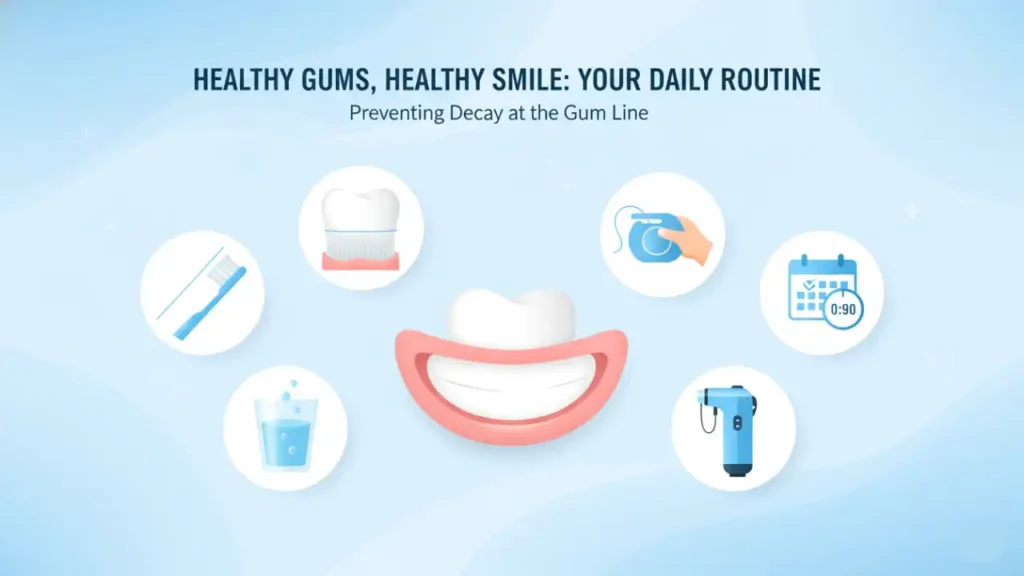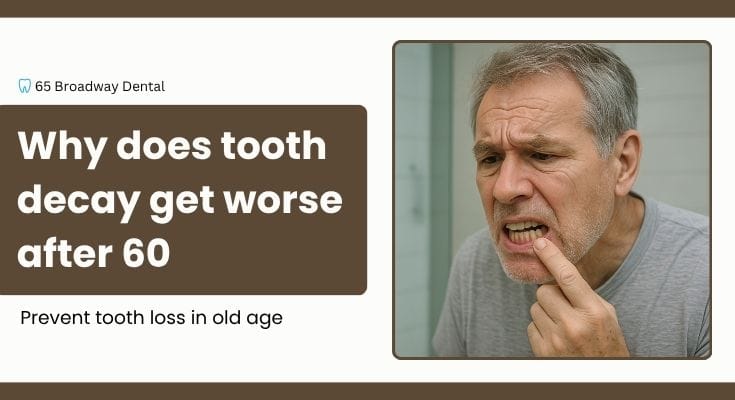Tooth Decay at Gum Line Treatment: Your No-Nonsense Guide to Fixing
Ever felt that sharp sting when your toothbrush touches the edge of your gum? Or noticed a little dark line near your gum that just doesn’t look right? That could be tooth decay at the gum line, and trust me, it’s more common than you think.
When your gums start to recede, they expose the softer part of your tooth root. This makes it easier for bacteria to sneak in and cause problems. Before you know it, you’re dealing with pain, sensitivity, and maybe even a visible cavity at the gum line. If you’ve been skipping checkups, here are the signs you need a dental checkup.
The good news is that tooth decay at gum line treatment is simple and effective when caught early. From quick dental fillings to smart home remedies for gum line cavities, you have plenty of options to protect your smile. Learn how regular cleanings help prevent early decay in our step-by-step dental cleaning guide.
In this guide, you’ll learn everything you need to know, from what causes tooth erosion at the gum line, how dentists treat it, and whether you can fill a cavity below the gum line, to the real tooth decay at gum line treatment cost and safe steps you can take at home.
We’ll also talk about long-term treatment for tooth decay at the gum line and how to stop tooth decay around the gum line from coming back. Think of this as your friendly, no-fluff guide to keeping your teeth and gums healthy, starting right now.
What Exactly Is Tooth Decay at the Gum Line?
Imagine your tooth like an iceberg. The part you see above the gums is the strong enamel, and the part below is the softer root. When your gums start to pull back because of things like aging, brushing too hard, or gum disease, that soft root becomes exposed.

Learn more about gum disease warning signs and treatment to stop gum recession early. Once that happens, bacteria can easily attack the surface, leading to tooth decay around the gum line.
This type of decay is not the same as a normal cavity on the chewing surface. It spreads faster because the root surface, called cementum, is much softer than enamel. That’s why tooth erosion at the gum line treatment needs quick care from your dentist before it worsens.
Dentists often refer to this problem as a “root cavity” or “Class V cavity.” It might sound technical, but it simply means decay has started right where your tooth meets your gum.
According to the American Dental Association, one in four adults over 50 now has this type of decay. If you brush too hard, drink soda often, or skip flossing, you are giving bacteria the perfect chance to cause trouble. Check out our brushing techniques guide for a safer, gentler brushing routine.
The good news? Tooth decay at gum line treatment can fix this issue effectively. Whether you’re curious about gum line cavity home remedies, wondering you can fill a cavity below the gum line, or looking to understand the tooth decay at gum line treatment cost, there are safe and effective solutions available.
Why Do I Have Decay Around My Gum Line?
Let’s be honest, your mouth didn’t suddenly decide to cause trouble. Tooth decay around the gum line usually happens because of a few everyday habits that slowly wear down your teeth and gums. Here’s what might be going on.
The Usual Suspects (You’re Probably Doing at Least One)
- Plaque buildup under the gums: When food and bacteria mix, they form a sticky layer that turns into acid. Over time, this acid starts attacking your tooth and causes tooth erosion at the gum line, leading to decay.
- Brushing too hard: Using a hard-bristled brush or scrubbing too aggressively can wear away your gums, exposing the softer root surface. That’s when tooth decay at the gum line treatment becomes necessary.
- Sugary drinks and no rinse: Sipping on soda, coffee, or sweet drinks leaves acids on your teeth for up to 30 minutes after every sip.
- Dry mouth: Not drinking enough water, snoring, or taking certain medications can reduce saliva, which normally protects your teeth. See the top dry mouth causes and natural solutions.
- Grinding your teeth: If you grind your teeth at night, you can wear down enamel near your gums and increase your risk of decay.
Who’s Most Likely to Get Tooth Decay at the Gum Line?
- Over 40: Gums naturally recede with age, exposing more of the tooth root. Discover why tooth decay accelerates after 60 and how to slow it down.
- Smokers: Nicotine limits oxygen and slows gum healing.
- People with diabetes: High blood sugar can feed bacteria, increasing your risk of cavities.
- Those on certain medications: Some antidepressants and blood pressure pills can cause dry mouth, which makes things worse.
“Is This You?” Quick Risk Checker
| You Do This | Decay Risk | Fix It With |
|---|---|---|
| Brush like a power washer | High | Use soft bristles and brush for 2 minutes |
| Skip flossing | Very High | Try a water flosser or floss picks |
| Love soda, wine, or citrus | High | Use a straw and rinse with water after |
| Snore or take drying meds | Medium | Chew xylitol gum and stay hydrated |
How Do I Know If I Have a Cavity at the Gum Line?
Not every cavity screams for attention. Sometimes it starts quietly and shows up as small, sneaky signs you might easily miss. Here’s what to look for if you think you might need tooth decay at gum line treatment.
- A sharp sting with hot or cold drinks: If that first sip of iced tea or hot soup makes you wince, it could cause early tooth decay around the gum line.
- A thin brown or black line near your gum: It may look like a tiny shadow or stain, but it’s often the first visible sign of decay.
- Bleeding gums in one spot: If your gums bleed only when you floss one area, it might mean decay or irritation from plaque buildup.
- Lingering sensitivity after sweets or coffee: Pain that lasts a few seconds after eating sugar or drinking something warm can be a clue that decay has started.
- Bad breath that won’t go away: When bacteria hide under the gum, even mouthwash can’t fully get rid of the smell.
Whether it’s a small spot or a deeper problem, getting checked early can save time, money, and discomfort. Your dentist will guide you on everything from cavity at gum line treatment options to the tooth decay at gum line treatment cost and even simple gum line cavity home remedies to help ease symptoms until your appointment.
Can You Fill a Cavity Below the Gum Line? (Spoiler: Yes, But…)
The short answer is yes, you can fill a cavity below the gum line, but it’s a bit more complicated than a regular filling. Think of it like fixing a leak under your carpet, you have to lift the carpet before you can repair what’s underneath.
Early Decay? Fluoride Can Save the Day
If your dentist catches the problem early, usually within the first six to twelve months, tooth decay at gum line treatment might be as simple as applying a high-strength fluoride varnish. This helps rebuild and harden the affected area before it turns into a full cavity.
Cost: $35–$80 per visit
Pain: None
Time: Around 5 minutes, and you’re done!
Need a Filling? Here’s What Happens
If the decay has progressed, your dentist will clean out the damaged area and fill it with a tooth-colored material called composite resin.
- Above the gum line: The process is quick, drill, clean, fill, and seal with a blue curing light. It usually takes about 30 minutes.
- Below the gum line: Things get a little more involved. You’ll likely need a minor procedure called crown lengthening. This lifts the gum slightly to expose the cavity so your dentist can properly clean and fill it.
Think of it like gently lifting the gum “curtain” to fix the wall underneath.
Cost: $1,000–$3,000 (including surgery and filling)
Recovery: 1–2 weeks of soft foods and careful brushing
When It’s Too Deep (Root Canals and Crowns)
If the decay reaches the tooth’s nerve, you’ll need a root canal followed by a crown to protect the tooth. The dentist removes the infection, seals the root, and places a crown on top for strength. Curious which crown material lasts longest? Here’s the best material for dental crowns.
Pain: Minimal with anesthesia and medication
Cost: $700–$1,500 for the root canal + $800–$1,500 for the crown
Recovery: 3–7 days
Treatment Comparison Table
| Option | Best For | Pain Level | Average Cost | Recovery Time |
|---|---|---|---|---|
| Fluoride Varnish | Early white or brown spots | None | $35–$80 | Same day |
| Composite Filling (Above Gum) | Small surface cavities | Low | $150–$300 | 1 day |
| Crown Lengthening + Fill | Decay below gum line | Medium | $1,000–$3,000 | 1–2 weeks |
| Root Canal + Crown | Deep decay reaching nerve | Medium | $1,500–$3,000 | 3–7 days |
If your cavity is below the gum line, your dentist will explain which treatment for tooth decay at the gum line works best for you. Whether it’s fluoride, a filling, or a root canal, every approach helps stop tooth erosion at the gum line and prevent further damage.
Even if cost is a concern, there are budget-friendly options for tooth decay at gum line treatment cost, and some gum line cavity home remedies can help you manage sensitivity until you’re ready for your dental visit.
How Much Does Tooth Decay at Gum Line Treatment Cost?
Let’s talk about money, no sugarcoating here. The tooth decay at gum line treatment cost can vary a lot depending on how deep the decay is, the type of procedure you need, and where you live.

Here’s a quick look at the average 2025 treatment costs in the U.S. (without insurance):
- Basic filling (above the gum): $150–$300
- Crown lengthening surgery (for cavities below the gum line): $1,000–$3,000 per tooth
- Root canal treatment: $700–$1,500
- Dental crown: $800–$1,500
- Deep cleaning (if your gums are inflamed): $300–$400 per quadrant
These prices can change based on your dentist’s experience, location, and whether your case involves tooth erosion at the gum line treatment or deeper decay near the root. If cost is a concern, check our guide on dental care on a $50 plan.
What Insurance Actually Covers
Most dental insurance plans cover a portion of the cost, but it’s good to know what’s realistic:
- Fillings: 50–80% covered
- Root canals: 50–70% covered
- Crown lengthening: Often not covered because it’s considered cosmetic under some plans
If you’re unsure, ask your dentist for a pre-treatment estimate so you know what your out-of-pocket cost will be for your treatment for tooth decay at the gum line.
Smart Ways to Save Money
You don’t need to break the bank to take care of your teeth. Here are a few money-saving tips for tooth decay at gum line treatment:
- Visit dental schools: They offer treatments supervised by professionals at 50–70% lower prices.
- Ask about payment plans or CareCredit: Many offices offer 0% interest for 6–24 months.
- Catch it early: Treating early with fluoride ($50) can help you avoid surgery that costs thousands. Learn how preventive dental care keeps your bills low and your smile strong.
- Get multiple quotes: Prices can vary a lot depending on your zip code, so always compare 2–3 clinics.
Fixing tooth decay around the gum line early is not just cheaper, it’s faster and less painful, too. Even small gum line cavity home remedies can help reduce sensitivity before your appointment. So if you notice early signs, don’t wait. The sooner you act, the less you’ll spend.
Are There Gum Line Cavity Home Remedies That Actually Work?
Let’s be real, you can’t fill a cavity at home. No toothpaste, baking soda, or charcoal powder will magically fix a hole in your tooth. But the good news is that some gum line cavity home remedies can help slow down tooth decay around the gum line, ease discomfort, and protect your teeth until you see your dentist.
Here are a few dentist-approved tricks that can actually help:
- Saltwater rinse:
In a cup of warm water, combine half a teaspoon of salt. Twice daily, swish it around your mouth for 30 seconds. This helps kill bacteria, reduce swelling, and support healing around the gums. - Clove oil:
Dip a cotton bud in clove oil and gently dab it on the sore spot. It’s a natural numbing agent that provides instant relief. If it feels too strong, dilute it with a little coconut oil. - Oil pulling:
Swish one tablespoon of coconut oil in your mouth for 5–10 minutes, then spit it out. This old remedy helps pull out bacteria and plaque, giving your mouth a cleaner feel and helping slow tooth erosion at the gum line. - Aloe vera gel:
Rub a bit of pure aloe vera gel directly on your gums. It helps calm inflammation and soothes sore areas, especially if you’re waiting for treatment for tooth decay at the gum line.
Find out if natural oral health habits can help you maintain healthier gums at home.
These tooth decay at gum line treatment home tips are great for short-term relief, but remember, they won’t replace professional dental care. Use them for one to two weeks at most. If the pain gets worse, or you notice swelling or pus, visit your dentist right away.
Your dentist can check how deep the cavity goes and suggest the right cavity at gum line treatment, whether it’s fluoride, a filling, or something more advanced like can you fill a cavity below the gum line procedures. The earlier you act, the simpler and cheaper your tooth decay at gum line treatment cost will be.
How Can I Prevent Tooth Decay at the Gum Line Forever?
When it comes to your teeth, prevention is way easier (and cheaper) than treatment. A few small daily habits can protect you from ever needing tooth decay at gum line treatment again. Here’s your simple 90-second daily routine to keep your gums and teeth healthy for life.

Your 90-Second Daily Shield
- Brush gently: Use a soft-bristled toothbrush and angle it 45° toward your gums. Brush for two minutes twice a day to remove plaque without damaging your enamel or gums.
- Floss like you mean it: Floss once a day or use a water flosser if your gums are sensitive. This clears out bacteria hiding between teeth that cause tooth decay around the gum line.
- Rinse after acidic foods or drinks: After soda, wine, or citrus, rinse with plain water or a fluoride mouthwash within 30 minutes. This helps neutralize acids that lead to tooth erosion at the gum line.
Check out our list of the best and worst foods for better teeth.
Bonus Habits for Stronger Teeth
- Chew xylitol gum after meals: It helps stop bacteria from feeding on leftover sugars.
- Stay hydrated: Saliva is your mouth’s natural cleaner, keeping bacteria and acids in check.
- Wear a night guard if you grind: It protects the edges of your teeth from enamel wear.
- Visit your dentist every 6 months: Regular cleanings and X-rays catch early decay before it turns into a full cavity at the gum line or a costly tooth decay at gum line treatment cost situation.
See how your oral health affects your overall health and why consistent care matters.
Conclusion
That little dark line near your gum isn’t the end of the world. With the right tooth decay at the gum line treatment, your smile can bounce back stronger than ever.
If it’s caught early, your dentist can stop the damage with a quick fluoride treatment or a small filling. If it’s deeper, a minor procedure like crown lengthening or a root canal can save the tooth and prevent future problems.
The key is to act fast and not ignore the signs. Whether you’re exploring gum line cavity home remedies, wondering if you can fill a cavity below the gum line, or comparing tooth decay at gum line treatment cost, there’s always a solution that fits your needs.
If you’re ready to upgrade your smile, explore our cosmetic dentistry appointments in NYC.
Stay consistent with brushing, flossing, and regular checkups, and you’ll rarely need treatment for tooth decay at the gum line again. Your teeth aren’t doomed. They just need a little attention, and you’ve got this.
FAQs
1. What causes tooth decay at the gum line?
Tooth decay at the gum line happens when plaque and bacteria build up near the gums. Over time, acids from bacteria break down the tooth’s surface, especially if your gums have receded due to aging, brushing too hard, or gum disease.
2. Can you fill a cavity below the gum line?
Yes, a dentist can fill a cavity below the gum line, but it often requires a small gum surgery called crown lengthening to expose the decayed area. Once the cavity is visible, it can be cleaned and filled safely.
3. How much does tooth decay at gum line treatment cost?
The cost depends on the severity of decay and the treatment type. A basic filling may cost $150–$300, while deeper treatments like crown lengthening or a root canal can range from $1,000 to $3,000 per tooth.
4. Are there any gum line cavity home remedies that work?
Home remedies can’t cure a cavity, but they can ease pain and slow down decay. Saltwater rinses, clove oil, and coconut oil pulling can reduce bacteria and inflammation until you visit your dentist.
5. How do I know if I have a cavity at the gum line?
Common signs include sensitivity to hot or cold drinks, a brown or black line near the gum, bleeding while brushing, and bad breath that doesn’t go away. If you notice any of these, see your dentist for an exam.

Dr. Alexander Heifitz (Author)
Dr. Alexander Heifitz is the founder of 65 Broadway Dental in NYC, where he combines advanced dental expertise with a patient-first approach. He specializes in cosmetic and restorative treatments such as dental implants, veneers, Invisalign, and smile makeovers, helping New Yorkers achieve both oral health and confidence.
Booking An Appointment
Looking for a reliable dentist in Downtown NYC? Whether you need a routine cleaning, urgent care, or a full smile transformation — we’ve got you covered. We accept most PPO insurance plans and offer flexible scheduling.
+1 (212) 430-3888
Call for appointment
Walk-ins Welcome / Same-Day Appointments Available

Related Blogs

Factors That Accelerate Tooth Decay in People Over 60
Tooth decay often worsens after 60 due to dry mouth, gum recession, medications, poor diet, and reduced saliva flow, increasing cavity risk.
Read More
The Hidden Sugar in Healthy Kids’ Food
Is your child struggling with cavities or low energy? Discover which kids’ foods contain the highest sugar and how to make healthier choices.
Read More